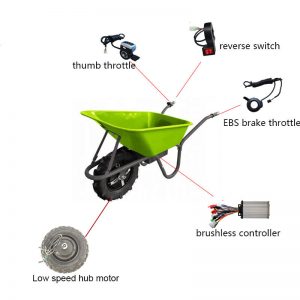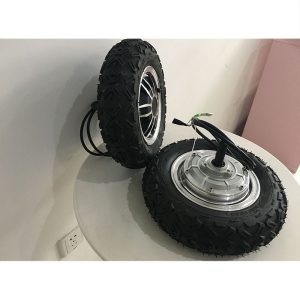A brushed DC motor uses a configuration of wound wire coils, the armature, acting as a two-pole electromagnet. The current’s directionality is reversed twice per cycle by the commutator, a mechanical rotary switch. This facilitates flow of the current through the armature; thus, the electromagnet’s poles pull and push against the permanent magnets along the outside of the motor. The commutator then reverses the polarity of the armature’s electromagnet as its poles cross the permanent magnets’ poles.
A brushless motor, by contrast, utilizes a permanent magnet as its external rotor. In addition, it uses three phases of driving coils and a specialized sensor that tracks rotor position. As the sensor tracks the rotor position, it sends out reference signals to the controller. The controller, in turn, activates the coils in a structured way – one phase after the other.

Creating an electric garden wheelbarrow can be a rewarding project, but it requires some technical skills and knowledge of electrical systems. Here’s a basic outline to get you started:
Materials Needed:
1. **Wheelbarrow Frame**: You can either buy a new one or repurpose an old wheelbarrow frame.
2. **Electric Motor**: Look for a low speed high torque DC brushless motor suitable for your wheelbarrow’s size and weight capacity. Aim for a motor with enough torque to handle the load.
3. **Motor Controller**: This device regulates the speed and direction of the motor. Choose one compatible with your motor and power source.
4. **Battery**: Select a deep-cycle battery with enough capacity to power your wheelbarrow. Consider factors like weight and voltage requirements.
5. **Throttle**: You’ll need a throttle mechanism to control the speed of the motor. Options include potentiometers or PWM (Pulse Width Modulation) controllers.
6. **Wiring and Connectors**: Get appropriate wiring to connect the components safely. Use connectors compatible with your components for easy assembly and maintenance.
7. **Switches and Circuit Protection**: Incorporate switches to turn the system on and off, along with fuses or circuit breakers to protect against overloads.
Steps:
1. **Design and Planning**: Determine where you’ll mount the motor, battery, and controller on the wheelbarrow. Consider weight distribution and accessibility for maintenance.
2. **Motor Installation**: Attach the motor to the wheelbarrow frame securely. Ensure it’s aligned with the wheel for optimal performance.
3. **Battery and Controller Placement**: Mount the battery and controller in suitable locations, considering balance and accessibility. Make sure they’re securely attached to prevent movement while in use.
4. **Wiring**: Connect the components according to the wiring diagram provided with your motor and controller. Double-check all connections to ensure they’re secure and insulated to prevent short circuits.
5. **Throttle Installation**: Install the throttle mechanism in a convenient location, such as on the handle of the wheelbarrow. Connect it to the motor controller according to the manufacturer’s instructions.
6. **Safety Features**: Install switches to turn the system on and off easily. Incorporate fuses or circuit breakers to protect against overloads and short circuits.
7. **Testing and Calibration**: Before using the wheelbarrow, test the system thoroughly in a safe environment. Check for proper operation of the motor, throttle, and safety features. Calibrate the throttle for smooth acceleration and braking.
8. **Final Adjustments**: Make any necessary adjustments to improve performance or address any issues discovered during testing.
9. **Usage and Maintenance**: Once everything is working correctly, use the electric wheelbarrow as needed. Regularly inspect and maintain the components to ensure safe and reliable operation.
Remember, safety is paramount when working with electricity and moving machinery. If you’re not confident in your abilities, consider seeking assistance from a professional or experienced hobbyist.
*TECICLO, one-stop supplier for electric wheelbarrow motor kits, motor option for wheelbarrow: 10inch,13inch, 14.5inch, 15inch, 16inch.
Maintaining a hub motor is key to ensuring its longevity and performance. Here are some essential tips for keeping your hub motor in top shape:

1. **Regular Inspection**
– **Visual Checks**: Frequently inspect the hub motor for any visible signs of damage, such as cracks or loose components.
– **Listen for Unusual Noises**: Pay attention to any unusual sounds like grinding or rattling, which might indicate internal issues.
2. **Keep it Clean**
– **Avoid Water Exposure**: Although hub motors are designed to be weather-resistant, it’s best to avoid submerging them in water. Wipe off any mud or dirt with a dry cloth.
– **Clean the Exterior**: Use a damp cloth to clean the exterior, but avoid getting water into any electrical components.
3. **Check and Tighten Bolts**
– **Axle Bolts**: Ensure that the axle bolts are tight to prevent wobbling or misalignment.
– **Spokes and Nuts**: Inspect and tighten any loose spokes or nuts if your hub motor is part of a wheel with spokes.
4. **Monitor Battery and Electrical Connections**
– **Battery Maintenance**: Keep your battery charged and avoid deep discharges to prolong its life.
– **Check Connections**: Regularly inspect electrical connections to ensure they are clean and secure. Loose connections can cause performance issues.
5. **Lubrication**
– **Bearings**: Some hub motors have bearings that may require periodic lubrication. Check your manufacturer’s guidelines on the type of lubricant to use.
– **Avoid Over-Lubrication**: Too much lubricant can attract dirt and cause more harm than good.
6. **Alignment and Adjustments**
– **Wheel Alignment**: Ensure that the wheel is properly aligned and true. Misalignment can cause undue stress on the hub motor.
– **Brakes and Gears**: Regularly check that brakes and gears (if applicable) are properly adjusted and not interfering with the hub motor.
7. **Temperature Considerations**
– **Avoid Overheating**: Hub motors can overheat if used excessively. If you’re doing long rides or climbing steep inclines, take breaks to let the motor cool down.
8. **Professional Service**
– **Periodic Checks**: Have your hub motor serviced by a professional periodically, especially if you notice any issues or if it’s been a while since the last check-up.
9. **Follow Manufacturer Guidelines**
– **Service Recommendations**: Adhere to the manufacturer’s maintenance schedule and guidelines for your specific hub motor model.
– **Replacement Parts**: Use only recommended replacement parts to ensure compatibility and performance.
By following these tips, you can help ensure that your hub motor remains reliable and performs well over its lifespan.
A servo hub motor is a type of electric motor designed for precise control in applications where accurate position, speed, and torque control are critical. It’s a combination of two key technologies:
Hub Motor: This refers to a motor that is integrated directly into the hub of a wheel, commonly used in electric bicycles, scooters, and other wheeled electric vehicles. The motor drives the wheel directly without the need for external transmission systems like chains, belts, or gears, simplifying the design and reducing mechanical losses.
Servo Motor: A servo motor is an advanced type of electric motor that includes a feedback system (such as an encoder or resolver) and a control mechanism (often a dedicated servo controller) to provide precise control over position, speed, and torque. Servo motors are used in applications requiring high performance and accuracy, such as robotics, CNC machines, and industrial automation.
Features of a Servo Hub Motor:
- Precise Control: A servo hub motor can deliver highly accurate control of the motor’s position, speed, and torque, which makes it suitable for applications requiring tight tolerances and responsiveness.
- Efficiency: Hub motors are usually more efficient than traditional drive systems because they directly power the wheel, eliminating energy losses in mechanical linkages or gear systems.
- Compactness: By integrating the motor into the wheel hub, the design is simplified and more compact, allowing for more space in the rest of the vehicle for other components.
- Feedback Mechanism: The motor has a feedback loop (usually with sensors or encoders) to adjust the motor’s behavior dynamically in response to the vehicle’s speed, load, or terrain, providing better control.
Applications:
- Electric Bicycles and Scooters: Servo hub motors are used in electric bikes and scooters for smooth, controlled power delivery to the wheel, offering better speed regulation and torque control.
- Electric Vehicles (EVs): In some EVs, particularly smaller ones, servo hub motors are used in each wheel for better torque distribution and regenerative braking.
- Robotics and Automated Systems: Servo hub motors can also be used in robotics for applications like mobile robots or automated vehicles, where precise movement and positioning are required.
In summary, a servo hub motor combines the direct-drive simplicity of a hub motor with the precision control of a servo motor, offering both efficiency and accuracy for applications that need precise motion control in a compact form factor.